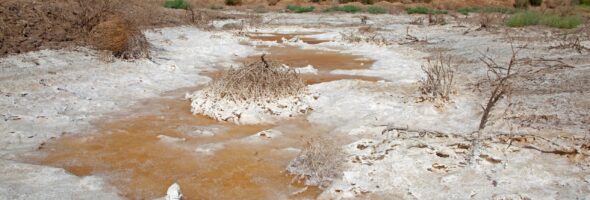Source: The Third Pole
May 18, 2023
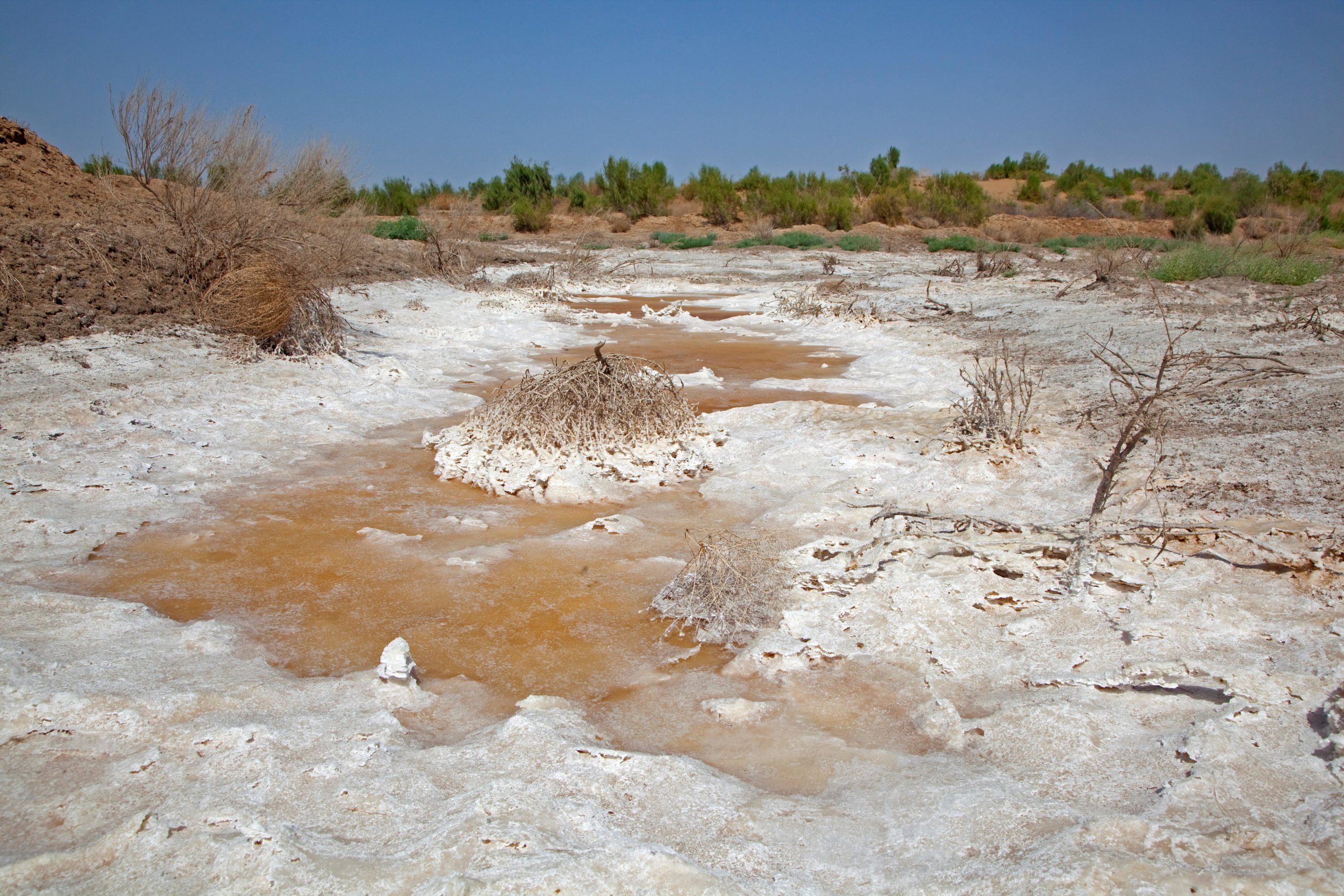
Salt deposits in the Karakum desert, Turkmenistan, where experts say the Karakum Canal has resulted in land being salinised and seasonally waterlogged, making agriculture impossible (Image: Alamy)
For more than 50 years, Afghanistan has contemplated building an enormous canal that will divert the waters of the Amu Darya River and irrigate the country’s dry northern plains.
In January this year, it became suddenly apparent that the project is well underway, with the release of a video by the Taliban. Since then, the Qosh Tepa canal, which may divert up to a third of the Amu Darya, has been the subject of international interest and concern.
“It is our own fault that we are not prepared for such a situation,” said Yusup Kamalov, an Uzbek ecologist who is chair of NGO the Union for the Defense of the Aral and Amu Darya.
Wider than the length of three Olympic swimming pools, already more than a third complete, and with 8.2 billion Afghan Afghanis (about USD 94 million) of public money spent on its first phase, the canal is intended to “turn 550,000 hectares of barren land into much-needed farmlands” for growing wheat and vegetable oil, Zabihullah Mujahid, spokesperson for Islamic Emirate of Afghanistan, told The Third Pole.
The canal is being built at a desperate time for the people of Afghanistan. Fazlullah Akhtar, an expert on water management from Kabul, pointed out that the country is totally dependent on foreign aid, with local food production unable to feed the population. “The current policies of the ruling regime have had disastrous impacts, with 20 million people acutely food-insecure, including six million on the brink of famine,” said Akhtar, who is now a senior researcher at the University of Bonn in Germany.
“On completion, [the canal] will provide jobs for around 250,000 Afghans in Jawzjan, Balkh and Faryab provinces,” added Haji Mukhtar, an ethnic Uzbek from Jawzjan province who was part of the team that worked on the Qosh Tepa canal under the former government.
Without the monsoon, Afghanistan depends on snowmelt and rivers
Unlike other South Asian countries, Afghanistan receives no water from the monsoons. Instead, it is dependent on sporadic rainfall and primarily snow and glacial melt to feed its rivers. Decades of war have led to a degraded hydrological management system, and in 2021 Afghanistan faced the worst drought in decades due to low snowfall in the winter. Managing the water in the country’s rivers is critical given the vast majority of Afghans are struggling with poverty, depend on agriculture and nine out of 10 people do not have enough to eat.
However, the project risks destabilising relations with downstream Uzbekistan and Turkmenistan, given the aridification crisis in the basin that long predates it. On 1 April a presidential decree in Uzbekistan issued measures to increase water efficiency, citing forecasts that water resources in the basin will fall by 15-20%.
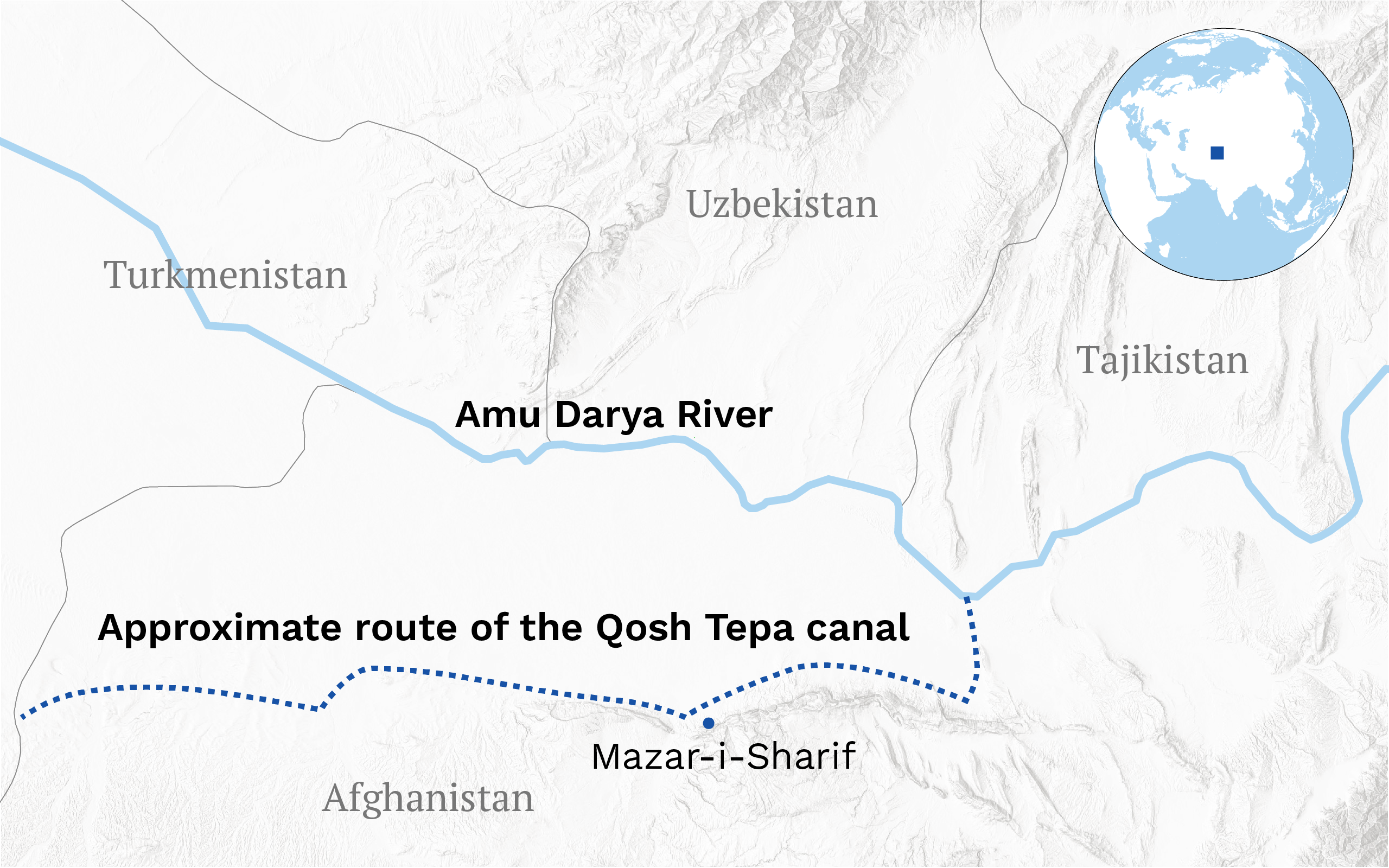
The Qosh Tepa canal may divert up to a third of the Amu Darya’s water • Map: The Third Pole
“The Qosh Tepa canal has already begun to cause regional tensions,” said Eugene Simonov, international coordinator of the Rivers without Boundaries, environmental coalition. This view was shared by multiple experts in Uzbekistan and Turkmenistan who spoke with The Third Pole.
At the same time, Simonov asserted, Afghanistan is not included in regional water agreements yet has a right to the Amu Darya’s resources – a view stressed by other experts and Taliban spokespeople.
Dropping water and rising tensions
Speaking at a roundtable in late April, Anatoly Sorokin of the Scientific-Information Center of the Interstate Commission for Water Coordination (ICWC) of Central Asia, said that the combined impact of low water levels and the Qosh Tepa canal could reduce the Amu Darya’s flow by 50%.
What is the Interstate Coordination Water Commission?
The ICWC is a framework for collaborative regional water management created under the 1992 Almaty Agreement. It manages water allocations and dispute resolution mechanisms.
The Almaty Agreement, signed by Kazakhstan, Kyrgyzstan, Tajikistan, Turkmenistan and Uzbekistan, regulates water allocations between the countries. It largely upheld water quotas under the Soviet Union, despite changes to national boundaries.
Vadim Sokolov, from regional institution the International Fund for Saving the Aral Sea, told The Third Pole that “any impact in the transboundary basin, which leads to changes in the structure of the water balance, definitely creates problems, including an increase in regional tensions”. Scientists have said that the canal could mean Uzbekistan and Turkmenistan have up to 15% less of the Amu Darya’s water to use for irrigation.
The pressures created by the canal will compound the impacts of climate change that are already affecting the region, stressed Kamalov, who is also a member of the public council of non-profit international organisation the Regional Environmental Centre of Central Asia (CAREC). “The presidents of Kyrgyzstan and Tajikistan have previously talked about losing 30% of the glaciers in their countries,” he pointed out.
Furthermore, the extraction of more water from the river means that “it will become fundamentally impossible to restore aquatic ecosystems in the Aral Sea region” Simonov anticipated, warning that the critically endangered false shovelnose sturgeon, also called the Amu Darya sturgeon, will die out completely. The survival of fish in the lower reaches and the wetlands of the Amu Darya and Prearalie floodplains are also at risk, he said.
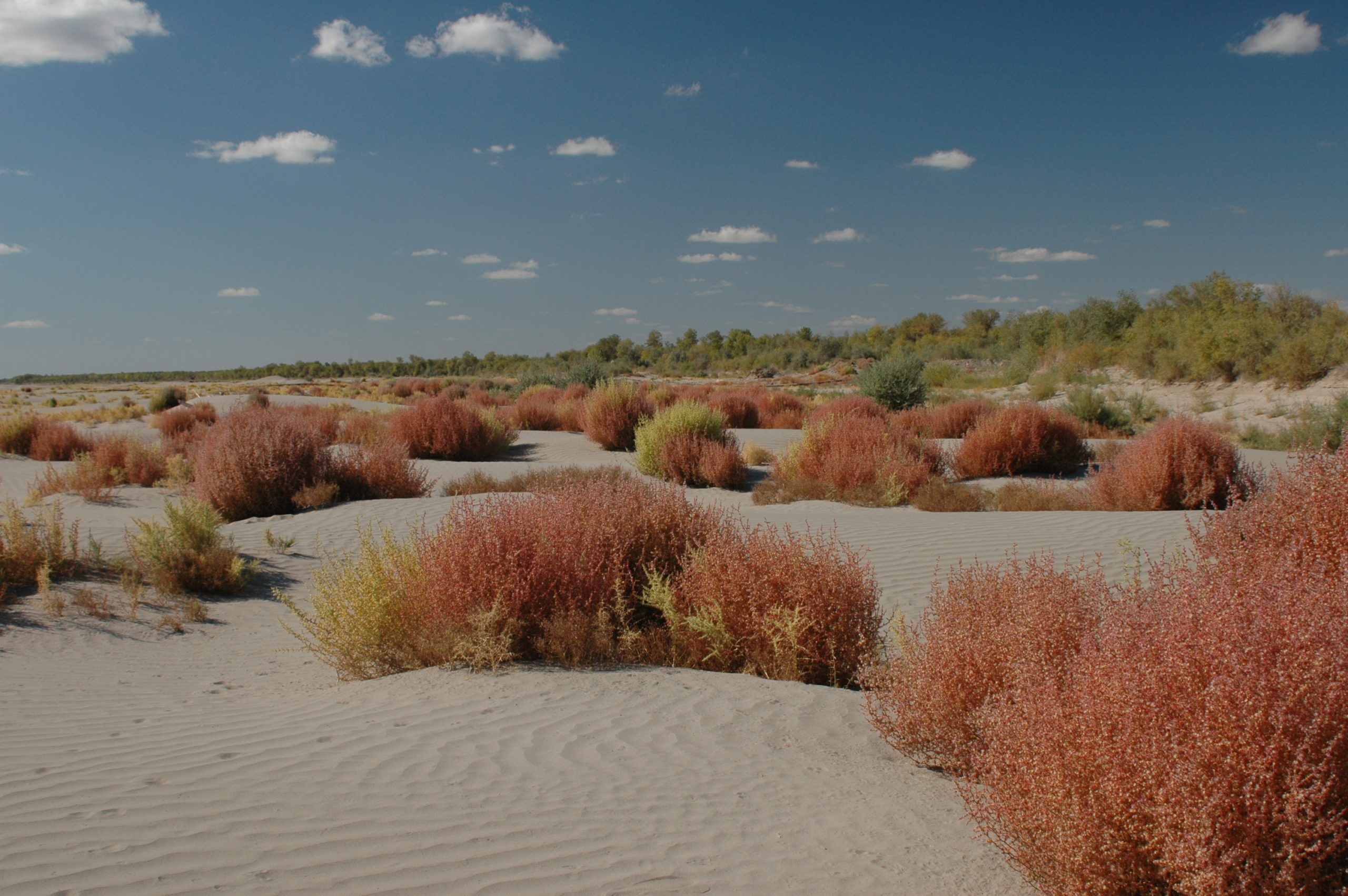
The Amu Darya riverbed in Uzbekistan, in 2012 (Image: United Nations Development Programme / Flickr / CC BY-NC-SA 2.0)
Worries of widespread salinisation due to Qosh Tepa canal
While significant, the withdrawal of water from the Amu Darya is “not the most important, acute and potentially dangerous problem for the entire region”, a Turkmen geographer and ecologist said, speaking to The Third Pole on condition of anonymity.
Sayed Waliullah Aqili, former director of the Groundwater Department in Kabul, told The Third Pole: “The canal will have significant socio-economic and environmental impacts for the provinces and indirectly for the country that will also help recharge groundwater table in the irrigated area.”
However, the Turkmen expert said he feared that the canal will lead to widespread salinisation, both in Afghanistan and across the region – a concern shared by Sokolov and Kamalov.
“The canal almost at right angles crosses or skirts foothill plains, river deltas, which have their own established hydrological and hydrodynamic regime,” he said. This, he explained, will disturb the current drainage of groundwater into the Amu Darya, resulting in a rise in the groundwater level and salinisation of agricultural land.
“Part of the lands will not only be salinised, but also [seasonally] waterlogged, which will also take them out of agricultural turnover,” said the geographer, who has studied similar impacts around the Karakum Canal in Turkmenistan. While this could be prevented by measures such as waterproofing the canal, he said “such ideas for the Qosh Tepa canal are not even discussed”.
This could have repercussions beyond Afghanistan. In arid Central Asia, the adoption of large-scale irrigated agriculture since the 1960s has resulted in salts accumulating in the soil. These must be constantly removed in drainage water if farming is to remain possible.
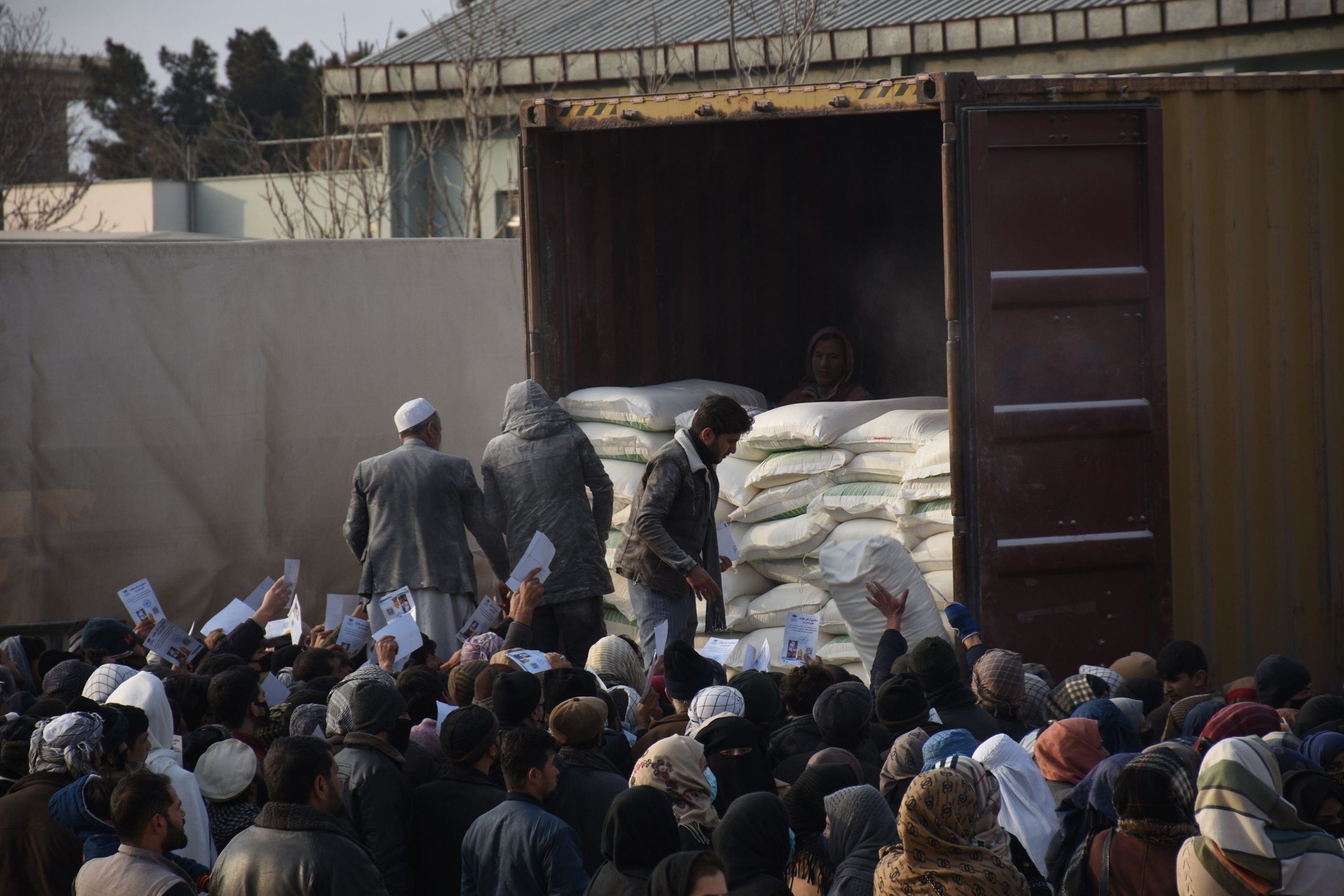
Humanitarian assistance in December 2021 in Mazar-i-Sharif, the capital of Balkh province, Afghanistan (Image: Alamy)
Salts will have to be continuously drained off the land in northern Afghanistan the Taliban intend to use for crops, the Turkmen expert added. The only place for this drainage water to go, he said, is the Amu Darya.
“Highly saline drainage water will flow into the river, complicating the already difficult – in some places disastrous – environmental situation in the middle course of the Amu Darya and especially in its lower reaches,” said the geographer. He added that the combination of the water deficit and increased salt content will complicate farming downstream of the canal, posing risks to public health and potentially necessitating the resettlement of populations in the most affected areas.
The need for a diplomatic solution
On 22 March 2023, a delegation from Uzbekistan visited Kabul. After this meeting, the Islamic Emirate stated that Uzbekistan was ready to cooperate in completing the Qosh Tepa canal project.
However, Uzbekistan has not yet publicly commented on the Qosh Tepa canal, aside from a statement by the Uzbek Ministry of Foreign Affairs that during the dialogue “special attention was paid to cooperation in the water and energy sectors”.
Speaking to The Third Pole in late March after the visit, Zabihullah Mujahid, spokesperson for the Islamic Emirate of Afghanistan, said that every state has a share of the Amu Darya’s water, and all of them have been using this except Afghanistan.
Ikramuddin Kamil, head of the transboundary rivers division at the Ministry of Foreign Affairs in Kabul, said that with its current infrastructure, Afghanistan can divert 5-6 billion cubic metres of water – which he said is less than 2% of the river’s total flow. As a result, Kamil says, “neighbouring countries in the past did not feel a sense of competition to reach an agreement with us”.
The Qosh Tepa canal will divert much more than this, at an expected 10 billion cubic metres.
“We will utilise our share and we want to devise a mechanism that is acceptable to and beneficial for all stakeholders in the region and not affect downstream users,” said Mujahid.
“Uzbekistan’s recent request for talks is a positive step towards promoting regional cooperation in sustainable water management,” said Kamil.
Speaking on condition of anonymity, an Uzbek official told The Third Pole in April that the country’s authorities are trying to resolve the situation peacefully.
“Negotiations with the Afghan side are held on a regular basis, but in a closed mode so as not to disturb society. Their government is behaving quite adequately to our proposals. But, unfortunately, we have no guarantees as to what will happen after the Qosh Tepa canal is completed,” he said.
To avoid conflicts in the future, the Uzbek official said they believe Afghanistan should join international agreements, and conclude bilateral and multilateral agreements on water use in the Amu Darya basin
Kamalov, from the Defense of the Aral and Amu Darya, adds that as well as Uzbek diplomats and specialists meeting with the Taliban, “Turkmenistan should play a key role in this issue. After all, 70% of the Amu Darya flows through Turkmenistan.”
Who can claim the Amu Darya’s waters?
Commentators attribute much of the current difficulty to the lack of agreements signed by Central Asian countries and Afghanistan on use and allocation of the Amu Darya’s waters.
The Almaty Agreement, signed by Kazakhstan, Kyrgyzstan, Tajikistan, Turkmenistan and Uzbekistan in 1992, regulates the allocation of water between the countries. It largely upholds water quotas set under the Soviet Union, despite changes to national boundaries.
“Afghanistan contributes 12% of the Amu Darya’s total flow but is excluded from the Almaty Agreement,” water management expert Fazlullah Akhtar told The Third Pole. Without Afghanistan’s inclusion, the entire regional water management regime is incomplete, said Kamil.
Simonov, of Rivers without Boundaries, said he believes that Afghanistan was “wrongfully excluded from cooperation within the framework of the Interstate Commission for Water Coordination (ICWC) and now it has taken this skeleton out of the closet”.
“At the same time,” he added “it is important to emphasise that as a country in the Amu Darya basin, Afghanistan has a full right to use waters of the Amu Darya and Panj. The issue is that all volumes of the Amu Darya’s waters that could be safely used have already been disposed of twice and three times by its neighbours.”
The Ministry of Foreign Affairs’ Kamil asserted that customary international law will apply to Afghanistan. For example, he said, the UN Convention on the Law of Non-Navigational Uses of International Water Courses favours early developers, yet doesn’t deprive late developers of their rights.
Afghanistan is also not a signatory to the 1992 UN Convention on the Protection and Use of Transboundary Watercourses and International Lakes. Turkmenistan and Uzbekistan have ratified the Convention, however. Yusup Kamalov said this means that the treaty “can already serve as a basis for interaction”.
Simonov agreed: “Often even the countries that have not signed [the Convention] still use the cooperation mechanisms described in it. But I am afraid it alone is not enough.”
“We need to conclude other treaties, both bilateral and multilateral,” Kamalov continued. “There is a lot of work for diplomats here. I hope the Center for Preventive Diplomacy in Ashgabat [Turkmenistan’s capital] will make its contribution to solving this problem.”
Simonov said that Afghanistan needs to be “urgently included” in the system of arrangements for the management and protection of shared river basins. “The question is whether this is politically possible and whether the Taliban government will want it.”
In his comments in late April, the ICWC’s Anatoly Sorokin stated that it is necessary to involve Afghanistan in the commission’s work, initially as an observer, and thereby transfer to the country some of the responsibility for the future of the basin and the Aral Sea.
A plea to conserve the Amu Darya’s resources
Ecologists and campaigners The Third Pole spoke with were keen to stress the importance of reducing water use across the basin in the wider context of the Qosh Tepa canal. Yusup Kamalov urged for canals to be made watertight, drip irrigation introduced, forests to be planted alongside rivers, and drought-resistant varieties of crop to be grown.
Simonov called for an assessment of the combined impact of multiple “wasteful” reservoirs, hydropower projects and canals in the basin, which he said could lead to a “large-scale socio-ecological catastrophe in the lower reaches of the Amu Darya”.
“All basin countries should be ready to revise their development plans,” he said, as “long-term cooperation in the field of ‘water resources development’ is possible only with all possible conservation of these resources and environmentally responsible planning.”


